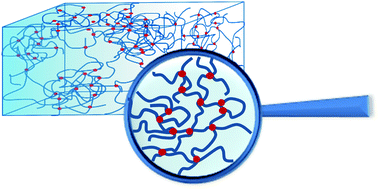当前位置:
X-MOL 学术
›
Soft Matter
›
论文详情
Our official English website, www.x-mol.net, welcomes your
feedback! (Note: you will need to create a separate account there.)
Dynamics-based assessment of nanoscopic polymer-network mesh structures and their defects
Soft Matter ( IF 2.9 ) Pub Date : 2018-02-19 00:00:00 , DOI: 10.1039/c7sm02444d Kay Saalwächter 1, 2, 3, 4 , Sebastian Seiffert 4, 5, 6, 7
Soft Matter ( IF 2.9 ) Pub Date : 2018-02-19 00:00:00 , DOI: 10.1039/c7sm02444d Kay Saalwächter 1, 2, 3, 4 , Sebastian Seiffert 4, 5, 6, 7
Affiliation

|
Polymer-network gels often exhibit complex nanoscopic architectures. First, the polymer-network mesh topology on scales of 1–10 nm is usually not uniform and regular, but disordered and irregular. Second, on top of that, many swollen polymer networks display spatial inhomogeneity of their polymer segmental density and crosslinking density on scales of 10–100 nm. This multi-scale structural complexity affects the permeability, mechanical strength, and optical clarity of the polymer gels, which is of central relevance for their performance in popular applications. As a result, there is a need to characterize the polymer network structures on multiple scales. On the scale of the spatial inhomogeneity of crosslinking, 10–100 nm, scattering of neutrons, X-rays, and light has extraordinary utility and is well established. On the scale of the mesh topology, 1–10 nm, in contrast, experimental techniques are less established. This review intends to close this gap by reviewing two intrinsically dynamic methods that yield information on polymer network mesh structures. First, NMR-based assessment of residual dipolar proton-spin couplings, which arise upon the introduction of crosslinks into a liquidlike polymer system to impart partial solidlike characteristics, is suitable to quantitatively assess network meshes and local network defects. Second, diffusive penetration of molecular, macromolecular, and mesoscopic colloidal probes through a polymer gel provides insight into its obstructing network mesh structure and its potential irregularity. Either method is highly synergistic to scattering-based assessment of the network structures on larger scales, and in concert, a rich picture on the nano- and mesoscopic gel topology is obtained.
中文翻译:

基于动力学的纳米级聚合物网络网状结构及其缺陷的评估
聚合物网络凝胶通常表现出复杂的纳米结构。首先,在1-10 nm尺度上的聚合物网络网状拓扑通常不是均匀规则的,而是无序不规则的。其次,最重要的是,许多溶胀的聚合物网络在10-100 nm的尺度上显示出其聚合物片段密度和交联密度的空间不均匀性。这种多尺度的结构复杂性会影响聚合物凝胶的渗透性,机械强度和光学透明度,这对于它们在流行应用中的性能至关重要。结果,需要在多个尺度上表征聚合物网络结构。在交联的空间不均匀性(10–100 nm)的范围内,中子,X射线和光的散射具有非凡的效用,并且已得到公认。相比之下,在网状拓扑的规模(1–10 nm)上,建立的实验技术较少。这篇综述旨在通过回顾两种在聚合物网络网格结构上产生信息的内在动力学方法来弥合这一差距。首先,对残留的偶极质子自旋偶合进行基于NMR的评估,这种评估是在将交联引入液体状聚合物体系以赋予部分固体状特征时产生的,适用于定量评估网络网格和局部网络缺陷。其次,分子,大分子和介观胶体探针通过聚合物凝胶的扩散渗透提供了对其阻碍的网状网状结构及其潜在不规则性的了解。两种方法都可以与基于散射的较大规模网络结构评估高度协同,并且一致地,
更新日期:2018-02-19
中文翻译:

基于动力学的纳米级聚合物网络网状结构及其缺陷的评估
聚合物网络凝胶通常表现出复杂的纳米结构。首先,在1-10 nm尺度上的聚合物网络网状拓扑通常不是均匀规则的,而是无序不规则的。其次,最重要的是,许多溶胀的聚合物网络在10-100 nm的尺度上显示出其聚合物片段密度和交联密度的空间不均匀性。这种多尺度的结构复杂性会影响聚合物凝胶的渗透性,机械强度和光学透明度,这对于它们在流行应用中的性能至关重要。结果,需要在多个尺度上表征聚合物网络结构。在交联的空间不均匀性(10–100 nm)的范围内,中子,X射线和光的散射具有非凡的效用,并且已得到公认。相比之下,在网状拓扑的规模(1–10 nm)上,建立的实验技术较少。这篇综述旨在通过回顾两种在聚合物网络网格结构上产生信息的内在动力学方法来弥合这一差距。首先,对残留的偶极质子自旋偶合进行基于NMR的评估,这种评估是在将交联引入液体状聚合物体系以赋予部分固体状特征时产生的,适用于定量评估网络网格和局部网络缺陷。其次,分子,大分子和介观胶体探针通过聚合物凝胶的扩散渗透提供了对其阻碍的网状网状结构及其潜在不规则性的了解。两种方法都可以与基于散射的较大规模网络结构评估高度协同,并且一致地,











































 京公网安备 11010802027423号
京公网安备 11010802027423号